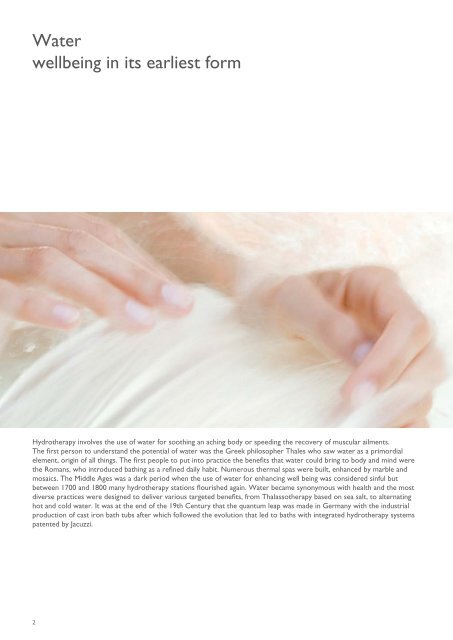- Page 1:
the collection 2011 home www.jacuzz
- Page 4 and 5:
Con Jacuzzi ® , il benessere prend
- Page 6 and 7:
vasche baths 6 docce showers 50 spa
- Page 9:
vasche baths Badewannen baignoires
- Page 12 and 13:
design Carlo Urbinati ·· Idromass
- Page 14 and 15:
design Carlo Urbinati ·· Grande a
- Page 16 and 17:
design Carlo Urbinati ·· Idromass
- Page 18 and 19:
design Jacuzzi ·· Idromassaggio c
- Page 20 and 21:
design Carlo Urbinati ·· Idromass
- Page 22 and 23:
design IED Centro Ricerche ·· Des
- Page 24 and 25:
22 aquasoul freestanding aquasoul l
- Page 26 and 27:
24 aquasoul built-in aquasoul loung
- Page 28 and 29:
26 nova freestanding/built-in nova
- Page 30 and 31:
28 j-sha mi j-sha mi corner folia f
- Page 33 and 34:
vasche senza idromassaggio non jett
- Page 36 and 37:
design Carlo Urbinati nova design
- Page 38 and 39:
design Carlo Urbinati anima design
- Page 40:
young folia design IED Centro Ricer
- Page 43 and 44:
41 aura uno design anima design bui
- Page 45:
43 versa freestanding/built in rive
- Page 49 and 50:
link
- Page 51:
49 link 160 x 70 x 225h cm 170 x 70
- Page 54 and 55:
design Pininfarina ·· Serie limit
- Page 56 and 57:
design Mario Ferrarini ·· Prestaz
- Page 58 and 59:
design Carlo Urbinati ·· Estetica
- Page 60 and 61:
design Synthesis Design ·· Spazio
- Page 62 and 63:
design Jacuzzi ® ·· Design d’a
- Page 64 and 65:
62 omega frame mynima 80 sphere myn
- Page 67 and 68:
spazio doccia shower space Duschber
- Page 69:
67 Esiste uno spazio in cui la cura
- Page 72:
piatti doccia moove collection show
- Page 76:
piatti doccia shape shower trays sh
- Page 80: chiusure surface enclosures surface
- Page 84: cristalli yncontra glass panels ync
- Page 88: es design Jacuzzi ·· Massima esse
- Page 91 and 92: ego design Jacuzzi ·· Forme pure
- Page 93 and 94: ei design IED Centro Ricerche ··
- Page 95 and 96: twice design Emo teak teak teak tec
- Page 97: nuda design Jacuzzi ·· Perfetta a
- Page 100: caleidos design Jacuzzi ® ·· Tec
- Page 103 and 104: chiusure enclosures Duschtüren fer
- Page 105 and 106: idrocolonne hydrocolumns Wassersäu
- Page 107 and 108: sanitari, rubinetterie e accessori
- Page 109 and 110: infinito
- Page 111 and 112: moove
- Page 113 and 114: morphosis
- Page 115 and 116: veya
- Page 117: ordo
- Page 120: 118 design Jacuzzi UK Design Studio
- Page 123 and 124: amea twin premium morphosis aura fl
- Page 125 and 126: j-service: essere anche nel servizi
- Page 127: spa pleasure design performance hea
- Page 132 and 133: When the Jacuzzi® brand became a h
- Page 134 and 135: Jacuzzi® brand. More than just a n
- Page 136 and 137: Your Jacuzzi® hot tub Hot tubs are
- Page 138: Hydrotherapy The effects of hydroth
- Page 141 and 142: 4 PowerPro ® FX jets Jacuzzi Power
- Page 143 and 144: Without CLEARRAY With CLEARRAY Th
- Page 145 and 146: 5° As the wellness path reaches it
- Page 147 and 148: 4. Increase your energy, not your e
- Page 149 and 150: • All wood used in our hot tub co
- Page 151 and 152: Can you use the spa in winter Yes,
- Page 154 and 155: seating capacity x3 x4 x5 italian d
- Page 157 and 158: x3 x4 x5 x6 p. 42 unique seating ca
- Page 159 and 160: Water has no boundaries This innova
- Page 162 and 163: santorini delos delfi unique italia
- Page 164: santorini pro design Kaluderovic &
- Page 168: delfi design Kaluderovic & Condini
- Page 172: Bulgari Hotel Spa Milan, Italy 44
- Page 176 and 177: J-400 premium Sing as you soak. All
- Page 178: J-495 x7-8 colours platinum 229 x 2
- Page 182:
J-465 x5 colours platinum desert sa
- Page 187 and 188:
x5 p. 62 J-LXL seating capacity 5 Y
- Page 189 and 190:
The clearest AquaSound The AquaSou
- Page 195 and 196:
x3 x5 x6 p. 78 J-315 seating capaci
- Page 197 and 198:
Manage your hot tub water with ease
- Page 200:
J-355 x5-6 colours platinum 231 x 2
- Page 204:
J-335 x4-5 colours platinum 213 x 2
- Page 209 and 210:
x4 x5 x6 p. 88 J-210 seating capaci
- Page 211 and 212:
Classic jets The classic jet collec
- Page 214:
J-230 213 x 213 x 91H cm seating ca
- Page 221 and 222:
x7 x8 p. 102 alimia experience buil
- Page 223 and 224:
Professional clean water. The quart
- Page 225 and 226:
2 1 Spa and piping system 12 1 - Ov
- Page 228 and 229:
virginia experience 257 x 219 x 98H
- Page 230 and 231:
alimia experience Ø237 x 98H cm se
- Page 232 and 233:
Porto Cervo, Sardegna, Italy 104
- Page 234 and 235:
Accessories for your Jacuzzi® hot
- Page 236 and 237:
Rattan accessories Exclusively for
- Page 238 and 239:
Wood accessories Exclusively for It
- Page 240 and 241:
Synthetic wood Exclusively for Prem
- Page 242 and 243:
Covers and energy saving These elem
- Page 244 and 245:
Cover lifters Exclusively for Premi
- Page 246 and 247:
Cleaning and Maintenance Cleaning s
- Page 248 and 249:
After sales service 120
- Page 250 and 251:
italian design profile BASE TOP SOU
- Page 252 and 253:
italian design delos BASE PRO PRO S
- Page 254 and 255:
italian design unique BASE TOP FEAT
- Page 256 and 257:
premium J-495 J-480 J-495 J-480 FEA
- Page 258 and 259:
premium J-LXL J-LXL FEATURES Length
- Page 260 and 261:
premium J-335 J-315 J-335 J-315 FEA
- Page 262 and 263:
professional sienna virginia SIENNA
- Page 264:
JACUZZI EUROPE S.p.A. Socio Unico D
- Page 268 and 269:
3 “Condivisione: da questa parola
- Page 271:
6 presenta sasha: il benessere di u
- Page 275 and 276:
10 sasha il benessere tre in uno Ja
- Page 277 and 278:
12 sauna sasha Calore intenso che p
- Page 279 and 280:
14 shower sasha sauna shower hammam
- Page 281 and 282:
16 hammam sasha sauna shower hammam
- Page 283:
18 Jacuzzi ® sasha programs sasha
- Page 286:
21 sauna + shower hammam + shower 2
- Page 290 and 291:
25 sasha hammam Versione SX - DX LH
- Page 293 and 294:
28 wellness firmato e certificato w
- Page 295:
30 JACUZZI EUROPE S.p.A. Socio Unic



